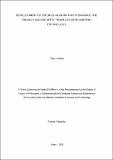| dc.contributor.author | Habibu, Taban | |
| dc.date.accessioned | 2020-09-14T08:04:20Z | |
| dc.date.available | 2020-09-14T08:04:20Z | |
| dc.date.issued | 2020-03 | |
| dc.identifier.uri | http://doi.org/10.58694/20.500.12479/900 | |
| dc.description | A Thesis Submitted in Partial Fulfillment of the Requirements for the Degree of
Doctor of Philosophy in Mathematical and Computer Science and Engineering
of the Nelson Mandela African Institution of Science and Technology | en_US |
| dc.description.abstract | The security of information and personal privacy are the growing concerns in today’s human
life worldwide. The storage of biometric data in the database has raised the prospect of
compromising the database leading to grave risks and misuse of the person’s privacy such as
growth in terrorism and identity fraud. When a person’s biometric data stored is revealed,
their security and privacy are being compromised. This research described a detailed
evaluation on several outbreaks and threats associated with the biometric technology. It
analyzed the user’s fear and intimidations to the biometric technology alongside the
protection steps for securing the biometric data template in the database. It is known that,
when somebody’s biometric data template is compromised from the database that
consequently might indicate proof of identity robbery of that person. Mixed method to
compute and articulate the results as well as a new tactic of encryption-decryption algorithm
with a design pattern of Model View Template (MVT) are used for securing the biometric
data template in the database. The model managed information logically, the view indicated
the visualization of the data, and the template directed the data migration into pattern object.
Factors influencing fear of biometric technology such as an exposer of personal information,
improper data transfer, and data misuse are found. Strong knowledge of the ideal technology
like the private skills of the biometric technology, data secrecy and perceived helpfulness are
established. The fears and attacks along the technology like a counterfeit of documents and
brute-force attack are known. The designed algorithm based on the cryptographic module of
the Fernet keys instance are utilized. The Fernet keys are combined to generate a multiFernet
key, integrated with biometric data to produce two encrypted files (byte and text file). These
files are incorporated with Twilio message and firmly stored in the database. The storage
database has security measures that guard against an impostor’s attack. The database system
can block the attacker from unauthorized access. Thus, significantly increased individual data
privacy and integrity. | en_US |
| dc.language.iso | en | en_US |
| dc.publisher | NM-AIST | en_US |
| dc.rights | Attribution-NonCommercial-ShareAlike 4.0 International | * |
| dc.rights.uri | http://creativecommons.org/licenses/by-nc-sa/4.0/ | * |
| dc.subject | Research Subject Categories::MATHEMATICS | en_US |
| dc.title | Development of secured algorithm to enhance the privacy and security template of biometric technology | en_US |
| dc.type | Thesis | en_US |


